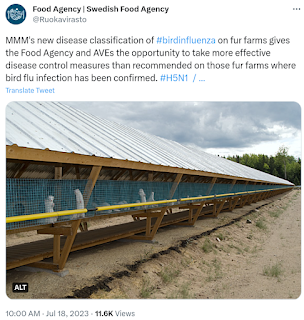After being caught powerless last week to regulate fur farms affected by avian flu, yesterday the Finnish Food Authority (Ruokavirasto) announced rule changes that would give them jurisdiction (see Finnish Food Agency Changes Disease Classification of Bird Flu on Fur Farms).
With 5 farms known to be affected, and thousands of animals exposed or infected, the losses for the fur industry are likely to be substantial. Investigations are reportedly underway in as many as 10 other fur farms.
While the source of infection of these 5 farms remains unclear, authorities are looking at a variety of sources of contamination, including feed and feed storage facilities. Today the Food Safety Agency issued the following orders to the feed industry.
Measures by feed industry operators to combat bird flu
July 19, 2023
Bird flu has been found in large numbers in wild birds this summer, and bird flu has also been found in fur animals. The spread of the infection in poultry or further in fur animals causes large losses and regional activity restrictions. Bird flu can also infect humans. Due to the seriousness of the situation and to prevent the spread of the disease, feed industry operators should also pay special attention to protective measures.The measures taken to combat bird flu are similar to the measures taken to combat other animal diseases - such as salmonella. Due to the bird flu situation, it is now necessary to observe special precision in these procedures. The cleanliness of the production and storage facilities as well as the transport equipment must be taken care of with sufficient cleaning measures and birds must be prevented from entering the premises. As far as possible, operators must ensure that there are no factors that attract birds, such as food that has fallen to the ground, in the facility area. The disease can also spread via transport equipment.The Food Agency The operating instructions for cargo mixers, feed transporters and farms to prevent the spread of salmonella also apply to the fight against avian flu, where applicable. Read more on the Food Agency's website: https://www.ruokavirasto.fi/elaimet/elainten-terveys-ja-elaintaudit/elaintaudit/siipikarja/lintuinfluenssa/ahkanohaista-lintuinfluenssasta/ .
While the fur trade has largely fallen out of favor in the United States, and fur farms have been recently banned in several EU nations, it is still a major industry in parts of Northern Europe, Russia, and China. In many places, particularly in Asia, there is little regulation (see China: Avian-Origin Canine H3N2 Prevalence In Farmed Dogs).
Many of the animals raised on these farms (e.g. mink, sable, foxes, raccoon dogs, etc.) have been shown to be highly susceptible to respiratory viruses - including influenza A and COVID - raising concerns over their potential role in generating a future pandemic virus.
A few (of many) past blogs on these concerns include:
CDC: New IRAT Risk Assessment On Mink Variant of Avian H5N1
Of course, the next pandemic could certainly emerge from the wild without being aided and abetted by human actions.
But by putting thousands of these highly susceptible animals into close quarters (often with poor biosecurity), we are giving H5N1 and SARS-CoV-2 (and other emerging viruses) ample opportunities to adapt to mammals and begin a world tour.
Over the past 3 years the amount of H5N1 in the environment has grown dramatically. Practices (like fur farming, letting your cat run free outdoors, or picking up a sick bird) that were presumably less dangerous prior to 2020 are arguably more dangerous now.
A bitter pill if you are in the fur business, or are a cat that likes its freedom, or work for a seabird rescue organization.
But we either find ways to adapt to this `new normal', or we run the risk that the virus will adapt to us instead.

